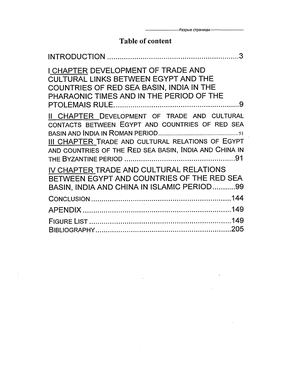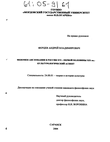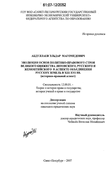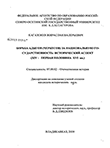Содержание к диссертации
INTRODUCTION 3
I CHAPTER DEVELOPMENT OF TRADE AND CULTURAL LINKS BETWEEN EGYPT AND THE COUNTRIES OF RED SEA BASIN, INDIA IN THE PHARAONIC TIMES AND IN THE PERIOD OF THE PTOLEMAIS RULE 9
ii chapter development of trade and cultural contacts between egypt and countries of red sea basin and India in Roman period 51
III CHAPTER Trade and cultural relations of Egypt and countries of the red sea basin, india and china in the Byzantine period 91
IV CHAPTER TRADE AND CULTURAL RELATIONS BETWEEN EGYPT AND COUNTRIES OF THE RED SEA BASIN, INDIA AND CHINA IN ISLAMIC PERIOD 99
Conclusion 144
APENDIX 149
Figure List 149
Bibliography 205
Введение к работе
THE OVERALL CHARACTERISTIC OF THE WORK Actuality of research
Geographical factor was crucial for development of the country in all periods of the Egyptian state history. Thanks to her geographical position Egypt was a crossroad of economical and political contacts between civilizations of the Mediterranean region, Near East and Africa. Egypt was very active in trade with such remote countries of Oicumena as India and China starting from the rule of the Ptolemies until XVI century.
However Egyptian ports on the Mediterranean and Red seas were both trade centers and hearths of very active exchange of ideas, places of meeting of different cultural traditions bearers. Since the period of the Greek dynasty of the Ptolemies rule when Egypt became powerful thalassocratia, port cities became outposts of cross-cultural and cross confessional dialog where ideology have been developed which outspread through the whole Africa and the Mediterranean region.
That is why study of the trade links of Egypt in our opinion is a subject of a special interest both from historical and cultural points of view. Although if a cultural aspect of the Mediterranean cities functioning is studied in details the influence of trade with India and China on the new ideas of Hellenistic, Roman, Byzantine and medieval Egypt is studied insufficiently. This gap in our knowledge could be fulfilled by scrutinizing of all sources concerning Egypt ports on the Red sea, which was an area of a very active interaction between Egyptian, India and China cultures.
Degree of scientific elaboration of the subject
The single problems of the subject "Trade contacts of Egypt with countries situated in the area of the Red sea, India and China" was studied in several monographic researches and articles. For instance a history of sea trade of Egypt in Pharaonic, Ptolemaic and roman periods is studied 1 О in a monograph of El-Abadi and Abdel Halim . In this book results of the authors archaeological excavations at the site Wadi Gawasis (the Red sea coast) are published. Here an anchorage of vessels sailing to Punt was situated. A very important place in the book is devoted to a description of an expedition to Punt which took a place in a reign of the queen Hatshipsut (XVIII dynasty of the New Kingdom); a very strong cultural output of the expedition is thoroughly studied.
In the book by L. Casson one of the chapter is devoted to the study of development of the sea trade in the Red and Mediterranean seas in Roman and Byzantine times. A very important contribution of this book is a commented translation of "Periplus of Eretreian Sea"4. This itinerary, which was compiled in the Roman period by a Greek traveler, describes a way from the Red sea to the Indian Ocean. The Periplus mapped all ports and anchorages with mentioning of distances between them and winds favorable for sailing in different periods of a year. A great attention L. Casson focused on study of cultural contacts of Greek-Roman world with countries of the Orient.
English archaeologist W.M.F. Petrie5 after conducting several seasons of archaeological excavations at Memphis advanced a hypothesis that a colony of Indian merchants existed in the city under the rule of the Ptolemais and later in the Roman period. He emphasized that Indian tradesmen kept the religious and cultural traditions of their mother country. Some finds let Petrie supposed that an area of the Indian merchants settling down stretched up to the Fayoum oasis.
In the researches by Leveque devoted to a problem of the cultures synthesis in the Hellenistic period the author focused on cultural links between Egypt and India during the Ptolemais6.
In the book by Warmington and in the work by Wheeler the whole picture of the Roman Empire and India interaction is drowning. Trade links of Egypt and India is thoroughly studied by Johnson9. Rostovzev scrutinized a subject of cultural influence of Egypt on the art of Persian and India10.
Shoff11, M.P. Charlsvorsa12, M. Rashke13 and others examined sea and land trade of the Roman Empire and the Orient in works. J.G. Breasted14 attended his works to the sea trade and cultural contacts between different parts of the Byzantine Empire and also between the state as a whole and foreign countries (India in particular) with reference to the Islamic period of Egypt history. The sea trade with India was researched by C. Taufik, S. Ahmed15, A. Battler16
Subject of the present research is cultural relations between Egypt and the countries of the Red sea basin, India and China in I-XVI AD in the context of development of trade links between Egypt countries of the above mentioned area
The present thesis is aimed at study of processes of cultural interaction between Egypt and the countries of the Red sea basin, India and China in I-XVI AD in the process of development of the sea trade in the Red sea and Indian ocean. Another aim of the research is the study of the port cities of the Red sea coast as centers of active cultural synthesis
The main objectives of the dissertation are:
- To determine main phases of the trade between Egypt and countries of the Red sea basin, India and China in I-XVI AD.
- To scrutinize archaeological sources concerning history of the Red sea port cities, which were, centers of different cultural traditions interactions.
Methodological background of the work Opinions of anthropologists-diffusionists (A. Grebner, L. Frobenius, W. X. Rivers, T. Heerdal and others), who paid their main attention to cultural contacts between different nations and who considered that it was the most important (sometimes cardinal) source of their cultural development, are the methodological basis of the work.
Methods Of research: comparative and iconographical analysis of sources. Overall conclusions are made on the basis of culturological and social psychological researches
Sources for the thesis research
- Results of archaeological excavations on the Red sea shore
- Written sources - works of Greek, Roman and Arab geographers and historians;
- Researches of Egyptian and foreign scholars, devoted to different problems of sea trade and cultural links between Egypt and countries of the Red sea basin, India and China in I-XVI AD.
Scientific hypothesis
We suppose that the supremacy of intolerable to another world outlook and strict religious systems was the main reason of a low level of cultural contacts between Egypt, India and China (especially during Byzantine and Arabian periods of Egyptian history). Certainly, religions have been changing throughout the history, but they systematically explained the structure of the world and rules of human activities and created the picture of the world. So, some kind of cultural synthesis was very difficult. It is an explanation of the fact that artifacts, reflecting such kind of synthesis, are found rarely. Moreover, apparently, there was no interest to each other between the Egyptians and the people of India and China. However, exactly trade relationships helped to establish cultural contacts between Egypt, India, China and the countries of the Red sea basin.
Scientific newness and theoretical significance of the work: For the first time in the contemporary cult urology a large-scale analysis of the interrelation and interaction of Egypt with cultures of the Red sea basin, India and China in Roman, Byzantine and Arab periods was carried out. Theoretical significance of the work is determined by the fact that the author reconstructed the process of a cultural synthesis, which took place in Red sea coast ports after thorough analysis of written sources. The great importance of the work is determined by the fact that archaeological data accumulated during archaeological excavations at Quseir el-Qadim (Myos Hormos) was introduced to scholars for the first time.
Practical importance of the work:
The data and results of the work could be used for
- Further historical researches of sea trade and cultural links between the Red sea basin, India and China in I-XVI AD;
- Culturological studies devoted to theoretical understanding of such topics as interrelations and interactions between different cultures in Ancient and Medieval times;
Lecturing and writing of appropriate chapters of books for high schools in humanities.



















